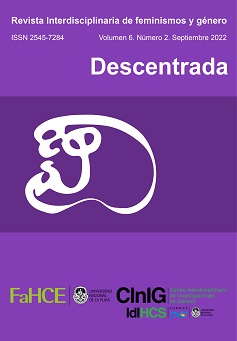Sucesos atléticos: deporte, género y cuerpos mentalizados
Contenido principal del artículo
Resumen
En este artículo me propongo profundizar, desde los Estudios de Género, en la relación mente-cuerpo en aquellos ámbitos donde la segregación por sexo suele justificarse de acuerdo con la idea extendida acerca de que una genitalidad explica la distribución binaria de ciertos estados psicológicos y comportamientos. En esta ocasión, me ocupo de la actual regulación olímpica y su legitimación respecto del vínculo causal entre testosterona y habilidad atlética. Incorporaré la idea de sucesos y la de cuerpos mentalizados para reinterpretar dicho vínculo en el marco de las normativas de género.
Descargas
Detalles del artículo

Esta obra está bajo una licencia internacional Creative Commons Atribución-NoComercial-CompartirIgual 4.0.
La cesión de derechos no exclusivos implica también la autorización por parte de los autores para que el trabajo sea alojado en los repositorios institucionales UNLP (Sedici y Memoria Académica) y difundido a través de las bases de datos que los editores consideren apropiadas para su indización, con miras a incrementar la visibilidad de la revista y sus autores.
Citas
Bassett, A. J., Ahlmen, A., Rosendorf, .J. M., Romeo, A. A., Erickson, B. J. y Bishop, M. E. (2020). The Biology of Sex and Sport. JBJS Rev, 8(3), 1-8. https://doi.org/10.2106/jbjs.rvw.19.00140 DOI: https://doi.org/10.2106/JBJS.RVW.19.00140
Bermon, S. (2017). Androgens and athletic performance of elite female athletes. Current Opinion, 24(3), 246-251. https://10.1097/MED.0000000000000335 DOI: https://doi.org/10.1097/MED.0000000000000335
Bermon, S. y Garnier, P. (2017). Serum androgen levels and their relation to performance in track and field: Mass spectrometry results from 2127 observations in male and female elite athletes. British Journal of Sports Medicine, 51(17), 1-7. https://doi.org/10.1136/bjsports-2017-097792 DOI: https://doi.org/10.1136/bjsports-2017-097792
Camporesi, S. (2019). When does an advantage become unfair? Empirical and normative concerns in Semenya's case. J Med Ethics, 45, 700-704. https://doi.org/10.1136/medethics-2019-105532 DOI: https://doi.org/10.1136/medethics-2019-105532
Cardinale, M. y Stone, M. H. (2006). Is testosterone influencing explosive performance? Journal of strength and conditioning research, 20(1), 103-107. https://doi.org/10.1519/r-16864.1 DOI: https://doi.org/10.1519/00124278-200602000-00016
Ciccia, L. (2020). La construcción biosocial de la identidad cis. En J. A. Ferreyra y J. A. Castorina (Comps.), Neurocientismo o Salud Mental: discusiones clínico-críticas desde un enfoque de derechos. Buenos Aires: Editorial Miño y Dávila.
Ciccia, L. (2022a). Sucesos comportamentales: estados mentales, cuerpo y género. Debate Feminista, 63, 3-29. https://doi.org/10.22201/cieg.2594066xe.2022.63.2311 DOI: https://doi.org/10.22201/cieg.2594066xe.2022.63.2311
Ciccia, L. (2022b en prensa). Sucesos depresivos: aportes para reinterpretar la salud mental desde una lectura no biologicista. En S. Guerrero y L. Ciccia (Coords.), Materialidades Semióticas. Ciencia y Cuerpo Sexuado. CEIICH: UNAM.
Ciccia, L. (2022c en prensa). El uso anacrónico de la categoría sexo en el ámbito biomédico: hacia la noción de bioprocesos en la era posgenómica. s/d.
Eliot, L. (2020). Sex/gender differences in the brain and their relationship to behavior. En F. M. Cheung y D. F. Halpern (Eds.), Cambridge international handbook on psychology of women. (pp. 63-79). Cambridge: Cambridge University Press. DOI: https://doi.org/10.1017/9781108561716.007
Eliot, L. (2021). Brain Development and Physical Aggression How a Small Gender Difference Grows into a Violence Problem. Current Anthropology, 62(23), 66-78. https://doi.org/10.1086/711705 DOI: https://doi.org/10.1086/711705
Handelsman, D. J., Hirschberg, A. L. y Bermon, S. (2018). Circulating testosterone as the hormonal basis of sex differences in athletic performance. Endocrine Review, 39(5), 803-829. https://doi.org/10.1210/er.2018-00020 DOI: https://doi.org/10.1210/er.2018-00020
Haas, R. et al. (2020). Female hunters of the early Americas. Science Advances, 6(45), 1-10. https://doi.org/10.1126/sciadv.abd0310 DOI: https://doi.org/10.1126/sciadv.abd0310
Haraway, D. (1995). Ciencia, ciborgs y mujeres, la reinvención de la naturaleza. Madrid: Ediciones Cátedra.
Healy, M. L., Gibney, J., Pentecost, C., Wheeler, M. J. y Sonksen, P. H. (2014). Endocrine profiles in 693 elite athletes in the postcompetition setting. Clin. Endocrinol, 81, 294–305. https://doi.org/10.1111/cen.12445 DOI: https://doi.org/10.1111/cen.12445
Heggie, V. (2010). Testing sex and gender in sports; reinventing, reimagining and reconstructing histories. Endeavour, 34(4), 157-63. https://doi.org/10.1016%2Fj.endeavour.2010.09.005 DOI: https://doi.org/10.1016/j.endeavour.2010.09.005
Hines, M. (2020). Neuroscience and Sex/Gender: Looking Back and Forward. The Journal of Neuroscience, 40(1), 37-43. https://doi.org/10.1523/JNEUROSCI.0750-19.2019 DOI: https://doi.org/10.1523/JNEUROSCI.0750-19.2019
Hirschberg, A. L. (2020). Female hyperandrogenism and elite sport. Endocr Connect, 9(4), 81-92. https://doi.org/10.1530%2FEC-19-0537 DOI: https://doi.org/10.1530/EC-19-0537
Hyde, J., Bigler, R., Joel, D., Charlotte, C. T. y Van Anders, S. (2019). The Future of Sex and Gender, Psychology: Five Challenges to the Gender Binary. American Psychologist, 74(2), 171-193. https://doi.org/10.1037/amp0000307 DOI: https://doi.org/10.1037/amp0000307
Joel, D., García-Falgueras, A. y Swaab, D. (2020). The Complex Relationships between Sex and the Brain. The Neuroscientist, 26(2), 156-169. https://doi.org/10.1177%2F1073858419867298 DOI: https://doi.org/10.1177/1073858419867298
Karkazis, K. y Jordan-Young, R. (2012). Out of Bounds? A Critique of the New Policies on Hyperandrogenism in Elite Female Athletes. The American Journal of Bioethics, 12(7), 3-16. https://doi.org/10.1080/15265161.2012.680533 DOI: https://doi.org/10.1080/15265161.2012.680533
Karkazis, K. y Carpenter, M. (2018). Impossible Choices: The Inherent Harms of Regulating Women’s Testosterone in Sport. Bioethical Inquiry, 15, 579-587. http://dx.doi.org/10.1007/s11673-018-9876-3 DOI: https://doi.org/10.1007/s11673-018-9876-3
Karkazis, K. y Jordan-Young, R. (2018). The powers of testosterone: Obscuring race and regional bias in the regulation of women athletes. Feminist Formations, 30(2), 1-39. https://doi.org/10.1353/ff.2018.0017 DOI: https://doi.org/10.1353/ff.2018.0017
Kerr, R. y Obel, C. (2017). Reassembling sex: reconsidering sex segregation policies in sport. International Journal of Sport Policy and Politics, 10(2), 305-320. https://doi.org/10.1080/19406940.2017.1406976 DOI: https://doi.org/10.1080/19406940.2017.1406976
Photopoulos, J. (2021). The future of sex in elite sport. Nature, 592, 12-15. Recuperado de https://media.nature.com/original/magazine-assets/d41586-021-00819-0/d41586-021-00819-0.pdf DOI: https://doi.org/10.1038/d41586-021-00819-0
Pielke, R. Tucker, R. y Boye, E. (2019). Scientific integrity and the IAAF testosterone regulations. Int Sports Law J, 4(23), 1-9. https://doi.org/10.1007/s40318-019-00143-w DOI: https://doi.org/10.1007/s40318-019-00143-w
Sőnksen, P. H. et al. (2018). Hyperandrogenism controversy in elite women’s sport: an examination and critique of recent evidence. Br J Sports Med, 52(23), 1481-1482. http://dx.doi.org/10.1136/bjsports-2017-098446 DOI: https://doi.org/10.1136/bjsports-2017-098446
Sőnksen, P. (2018). Determination and regulation of body composition in elite athletes. Br J Sports Med, 52(4), 219-229. https://doi.org/10.1136/bjsports-2016-096742 DOI: https://doi.org/10.1136/bjsports-2016-096742
Tipton, K. D. y Ferrando, A. A. (2008). Improving muscle mass: response of muscle metabolism to exercise, nutrition and anabolic agents. Essays Biochem, 44, 85-98. http://dx.doi.org/10.1042/BSE0440085 DOI: https://doi.org/10.1042/bse0440085
Woung, W. I. y Yeung, S. P. (2019). Early Gender Diferences in Spatial and Social Skills and Their Relations to Play and Parental Socialization in Children from Hong Kong. Archives of Sexual Behavior, 48, 1589-1602. https://doi.org/10.1007/s10508-019-1415-8 DOI: https://doi.org/10.1007/s10508-019-1415-8
Zachary DuBois, L. y Shattuck-Heidorn, H. (2021). Challenging the binary: Gender/sex and the bio-logics of normalcy. American Journal of Human Biology,33(5). https://doi.org/10.1002/ajhb.23623 DOI: https://doi.org/10.1002/ajhb.23623
